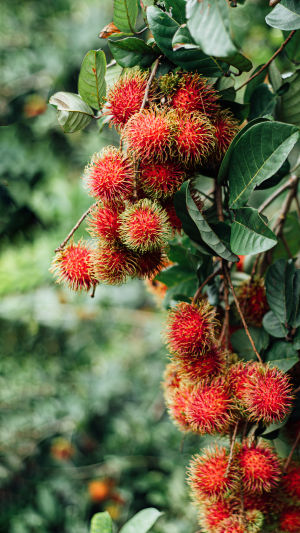Dear Lykkers! Rambutan, a spiky yet alluring tropical fruit, is known for its juicy, translucent flesh and distinct red, spiny skin.
Widely cultivated in Southeast Asia, especially in Thailand, Malaysia, and Indonesia, it’s often enjoyed for its sweet, slightly acidic taste that has hints of lychee and grapes. What makes this exotic fruit special?
<h3>Origins and Cultivation</h3>
The rambutan tree (*Nephelium lappaceum*) is native to the Malay-Indonesian region and thrives in humid, tropical climates. The tree can grow up to 20 meters tall and produces clusters of bright red or yellow fruits, each about the size of a small plum. Under optimal conditions, with abundant sunlight and ample rainfall, rambutan trees flourish, particularly during the wet season in tropical regions.
<b>Growing Requirements</b>
<b>Climate:</b>
Rambutan requires a consistently warm, tropical climate with high humidity and ample moisture to thrive. Temperatures between 22°C and 30°C (72°F to 86°F) are ideal for its growth.
<b>Soil:</b>
Rambutan prefers rich, well-draining soils, with a slightly acidic pH level of around 5.5 to 6.5, which helps support healthy growth.
<b>Harvesting:</b>
Rambutan trees typically begin to bear fruit after 3 to 5 years of growth. In favorable climates, these trees can produce two harvests per year, with peak production occurring during the rainy season.
How to eat Rambutan fruit | What does Rambutan Taste like
Video By In The Kitchen With Matt
<h3>Culinary Uses and Ways to Enjoy Rambutan</h3>
Rambutan’s juicy flesh and subtle sweetness make it a versatile ingredient in both sweet and savory dishes.
<b>Freshly Eaten</b>
The most popular way to enjoy rambutan is by eating it fresh. Simply peel off the skin to reveal the juicy, translucent flesh that encases the seed, making it a perfect and refreshing snack on its own.
<b>Salads and Desserts</b>
In fruit salads, rambutan adds a tropical flair, pairing well with fruits like mango, papaya, and pineapple. It also enhances desserts like ice creams, sorbets, and smoothies with its sweet and refreshing taste.
<b>Savory Dishes</b>
In Southeast Asian cuisine, rambutan is sometimes used in savory dishes, such as curries or seafood recipes, where its sweetness contrasts beautifully with spicy and tangy flavors. This combination creates a unique balance, particularly in dishes featuring chili and coconut milk.
<h3>Rambutan vs. Lychee and Longan</h3>
Rambutan is often compared to lychee and longan, two other tropical fruits with similar textures and flavors. However, there are key differences between them:
<b>Rambutan:</b>
Known for its hairy, spiky skin, rambutan has a slightly sweeter taste and creamier texture compared to lychee and longan. The flesh is juicy and translucent, with a flavor profile that is less floral and more mild, making it perfect for snacking or incorporating into both sweet and savory dishes.
<b>Lychee:</b>
Lychee has smoother, rougher skin and is slightly more floral in flavor. The flesh is firmer and juicier than rambutan, with a fragrance that gives it a unique, aromatic quality. Lychee’s sweetness is balanced by a slight tartness, giving it a distinct flavor profile in comparison to rambutan’s creaminess.
<b>Longan:</b>
Longan is smaller, with thin, smooth skin and a more subtle sweetness. The flesh is firmer and less juicy than both rambutan and lychee, offering a milder flavor that’s sometimes described as musky or slightly herbal. Its less intense sweetness makes it popular in traditional Southeast Asian soups and desserts.
Rambutan’s striking appearance and delicious flavor make it a treat for fruit lovers everywhere. With its health benefits and culinary versatility, this tropical fruit has earned its place as a prized delicacy worldwide. Whether enjoyed fresh or as a tropical twist in recipes, rambutan offers a taste of the tropics that is nutritious, refreshing, and utterly unique.





